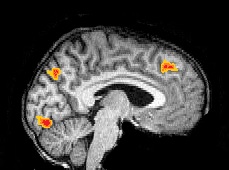
Tweet
September 12, 2014
Proceedings of the Natural Institute of Science | Volume 1 | SOFD 1
Assessment of the frequency with which men think of things: chicken wings
Carol J. Sanders1, Teresa B. Lowry2
1 - Department of Neurobiology, Generic State University, Collegetown, USA
2 - Department of Wherethemriis, Generic State University, Collegetown, USA

Introduction
It is well known that men think of sex approximately every 7 seconds (Brizendine 2006, beebee 2008, Between the Two of Us… 2008, Sim S & Solo 2008, Barry 2012, Rob 2013; although see Laumann et al. 1994 and Fisher et al. 2012 for rebuttals; click citations for links). This important and totally substantiated research has led to many great insights regarding the thought process and decision-making of human males (e.g., Limbaugh 2012). However, sex is the only thing we know that men think about, in terms of its frequency. Clearly, more research is needed on how often men think of other things in order to determine if the frequency with which men think about sex is greater or less than other important male activities. In addition, the more we know about how often men think about things, the better we will become at trying to predict their behavior.
Perhaps no other activity may be as important as sex to human males as the consumption of chicken wings (e.g., AP 2013, Moghe 2013, Norfleet 2013). According to the National Chicken Council, Americans consume roughly 27 billion chicken wings every year (NCC 2013). Assuming that males consume half of these wings, the average American male over 14 years of age consumes about 110 chicken wings per year. In comparison, American males have sex anywhere between 69 and 112 times per year, depending on age (Mosher et al. 2005). Thus, men may think about chicken wings just as often as they think about sex.
Methods
The cheapest method to determine the frequency with which men think of a particular thing is to equip them with a tally counter and keep track of the number of times they think of that particular thing (Fisher et al. 2012). A more expensive (i.e., better) method is to examine men’s brain activity patterns while exposed to the particular thing and then see how many times that activity pattern is repeated during some set period of time. We chose this latter option.
Brain activity was quantified using functional magnetic resonance imaging (fMRI). An fMRI measures changes in blood flow to different regions of the brain (Huettel et al. 2009): if a part of the brain experiences increased blood flow, then that part is probably in use. Past studies have successfully used fMRIs to uncover the brain patterns involved in such important activities as choosing brand-name soft drinks (McClure et al. 2004), rating the attractiveness of vehicles (Erk et al. 2002), and freestyle rapping (Liu et al. 2012).
Twenty men between the ages of 18 and 55 were selected to participate in this study. To establish baseline brain activity, all men were given an fMRI at the beginning of the study. Then, half of the group underwent an fMRI while eating chicken wings (Buffalo Wild Wings, Inc: Minneapolis, MN), while the other half underwent an fMRI while eating tofu (Vitasoy USA: Ayer, MA) as a control. As per the stipulations of our Human Subjects Protocol, this control group was given access to chicken wings at the conclusion of the study.
From these fMRIs, we determined the areas of the brain that experienced increased blood flow during the consumption of chicken wings. We then performed one final fMRI on each participant for one hour, and counted the number of times that specific region of the brain experienced an increase in blood flow.
Results
Figure 1 shows the parts of the brain that experienced the most increase in blood flow during the consumption of chicken wings, averaged across 9 of the 10 men (One of the participant’s fMRI showed the entire brain in use during wing consumption. Notably, this person ate the entire chicken wings, including the bones, and began to chew his sauce-stained fingers before being restrained by the attendants).
During the one-hour post-trial observation period, these exact portions of the brain were in use an average of 98 times. This means that, on average, the participants in our study thought about chicken wings every 36.7 seconds.

Discussion
In this paper, we have determined the parts of the brain that are associated with ‘thinking about chicken wings’ and the frequency with which these parts are activated in American males.
Three regions of the brain were activated when participants ate chicken wings (Figure 1): one in the frontal lobe, one in the parietal lobe, and one in the occipital lobe. The functions that these regions correspond to are the higher mental functions (such as concentration, planning, judgment and emotional expression), sensory association, and vision, respectively. Thus, we propose that during the consumption of a chicken wing, the brain goes through the following stages: 1) the brain ‘sees’ the chicken wing and recognizes it as such, 2) the brain plans the consumption of the wing (e.g., ‘What part of the wing will I eat first?’, ‘Should I lick some sauce off before I place it in my mouth?’, ‘Should I lick my fingers after each wing, or when I’m done with all of the wings?’, ‘Wait, was that Dan’s fourth or fifth wing he just ate?’), 3) the brain reaches maximum concentration capacity, 4) the sensory association area overloads as all five senses are stimulated, and 5) the brain judges the quality of the wing.
Our research shows that these three specific parts of the brain are activated approximately every 37 seconds, even in the absence of chicken wings, meaning that men think about chicken wings every 37 seconds. This frequency is about five times lower than the rate at which men think about sex. Thus men think about sex much more frequently, even though the number of chicken wings eaten per year is just about the same as the number of times men have sex. It is currently unknown as to why men think about sex so much (compared to chicken wings), but one possibility is that men aren’t very good at sex, but have mastered the consumption of chicken wings.
Our research also suggests that once every 259 seconds (see Figure 2), men think about both sex and chicken wings simultaneously, in what must be a most orgiastic thought. This might explain why men tend to drift off every 4 minutes or so: the blood levels in their brain are returning to normal after a combination sex-chicken wing thought.

We eagerly await further studies that examine the frequency with which men think about things. We also suggest future research on the thinking of chicken wings, such as: the effect of sauce on brain activity patterns, and the difference between bone-in and boneless wings.
References
AP (2013) Man accused of $10K chicken wing theft. http://www.myfoxny.com/story/22141312/man-due-in-court-in-conn-meat-theft-case.
Barry (2012) http://uk.answers.yahoo.com/question/index?qid=20121010110035AArpwQI.
Beebee (2005) http://uk.answers.yahoo.com/question/index?qid=20090618173542AAP6pkB.
Between the Two of Us… (2008) http://answers.yahoo.com/question/index?qid=20080830010142AAVM3mr.
Brizendine L (2006) The Female Brain. New York: Broadway Books.
Erk S, Spitzer M, Wunderlich AP, Galley L, Walter H (2002) Cultural objects modulate reward circuitry. NeuroReport 13:2499-2503.
Fisher B, Cullen F, Turner M (2000) The sexual victimization of college women. US Department of Justice Report. National Institute of Justice and Bureau of Justice Statistics, Washington, DC.
Fisher TD, Moore ZT, Pittenger M-J (2012) Sex on the Brain?: An examination of frequency of sexual cognitions as a function of gender, erotophilia, and social desirability. Journal of Sex Research 49:69-77.
Huettel SA, Song AW, McCarthy G (2009) Functional Magnetic Resonance Imaging (2 ed.), Massachusetts: Sinauer.
Laumann E, Gagnon JH, Michael RT, Michaels S (1994) The Social Organization of Sexuality: Sexual Practices in the United States. Chicago: University of Chicago Press.
Limbaugh R (2012) http://youtu.be/Jfb9f7yFYgw.
Liu S, Chow, HM, Xu Y, et al (2012) Neural correlates of lyrical improvisation: An fMRI study of freestyle rap. Scientific Reports 2:Article number 834.
McClure S, Li J, Tomlin D, Cypert KS, Montague LM, Montague PR (2004) Neural correlates of behavioral preference for culturally familiar drinks. Neuron 44:379–387.
Moghe (2013) Men accused of stealing $65,000 in chicken wings. http://www.cbsatlanta.com/story/20719453/men-accused-of-stealing-65000-in-chicken-wings.
Mosher WD, Chandra A, Jones J (2005) Sexual behavior and selected health measures: Men and women 15–44 years of age, United States, 2002. Advance data from vital and health statistics; no 362. Hyattsville, MD: National Center for Health Statistics.
National Chicken Council (2013) Americans to eat 1.23 billion chicken wings super bowl weekend.
Norfleet (2013) Second brother charged in St. Paul chicken wing theft. http://www.startribune.com/local/east/210508461.html.
Rob (2013) http://answers.yahoo.com/question/index?qid=20130821192143AADMKjl.
Sim S, Solo (2008) http://answers.yahoo.com/question/index?qid=20090502135530AAlSu3o.
Tjaden P, Thoennes N (2000) Full report of the prevalence, incidence, and consequences of violence against women. National Institue of Justice and the Centers for Disease Control and Prevention.fafce and the Centers for Disease Control and Prevention.

Proceedings of the Natural Institute of Science (PNIS) by https://instsci.org/ is licensed under a Creative Commons Attribution-ShareAlike 4.0 International License.